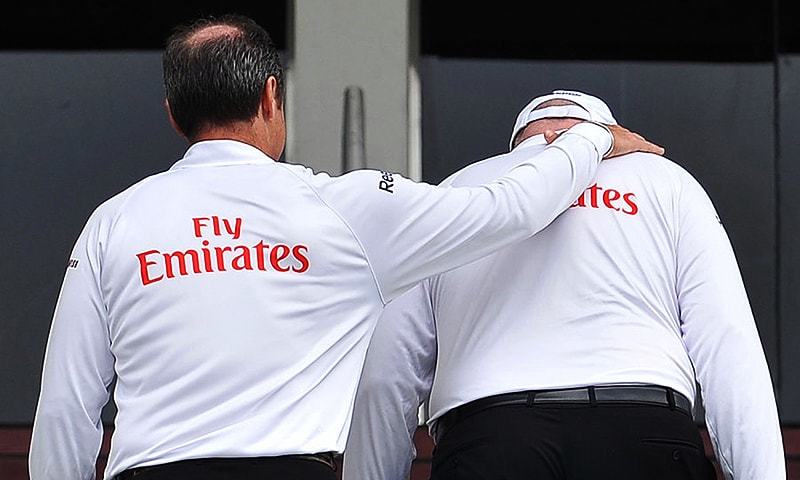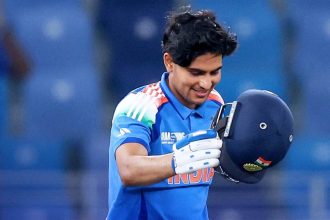“A person either lives for money or respect, but an umpire in Pakistan gets neither,” Saleem Badar says.
Badar, who made his international umpiring debut in the third Pakistan-Australia Test in Lahore in 1988, did not follow the path of his contemporaries by grinding it out on the First-class circuit and aspiring to put on the green jersey. However, he was very objective about his goals, which helped him in a 14-year career.
“I played club cricket at an early age but realized I was not good enough to compete with the others on the circuit. I had a weak financial background and needed to earn money, so I tried to excel in my career as an umpire.”
“Usually, former First-class players, who think they are fit enough to stand 100 overs and make accurate decisions on the field, head towards this field of cricket [umpiring],” Badar says, gazing at the wicket of the UBL Sports Complex.
The 62-year-old’s umpiring career comprises five Tests and 29 one-day internationals in the span between 1988 to 2002. He bid farewell after the Pakistan-West Indies series in the UAE but is still involved with the game as ICC’s umpire’s coach of Pakistan and hopes to raise the standard of the officials in the country.
The pillars of umpiring
The PCB offers a six-level umpiring course and charges a minimal fee, and there is no such eligibility criterion to get admitted into the program.
According to Saleem Badar, on is necessary to survive now [for umpires]. One has to attend ICC meetings, learn the new amendments, and communicate with fellow umpires, captains or ground staff because the language barriers could put you in deep trouble.”
The first two levels of the course are for beginners, and only international cricketers are exempted from it. Then there is the PIC (Penal Induction Course), where aspirants start officiating U-19, First-class and Grade-II games.
Only the first 42 basic laws of cricket are taught in the first two levels. The ICC provides artistically made interactive videos to appointed umpires’ coaches for learning. The videos explain each law in great detail, as Badar demonstrates with several videos related to run-outs. It covers all the different scenarios and the complications of the law.
Umpires’ performances in domestic matches are judged through the reports of both the playing captains and the match referee [if available]. If the officiated matches , umpires are filmed, their decisions are closely analyzed, and the top umpires are recommended to the ICC to stand in international matches.
There is hardly any favoritism in nominating umpires to the ICC, according to Badar.
“No matter who you nominate, the nominee must perform in their officiating matches. Otherwise, they will let down the whole country,” says Badar.
Umpires should be extremely tough, both mentally and physically. Contrary to popular belief that only football officials need to be physically fit, cricket umpires need to run, jog, spend hours in the gym and do everything to stay fit.
“Umpires stay in the field for 100 overs; they need to have a crocodile’s skin,” adds Badar.
Badar believes former First-class cricketers who start pursuing a career as an umpire before or around 40 usually succeed. The reason for that is simple, the on-field official has to give his verdict over an appeal within a fraction of a second, and “you need razor-sharp reflexes.”
Once an umpire starts standing in ODIs, it paves the way for the fourth level of the course. Badar, who has officiated three finals of the Asia Cup, said: “There is hardly anyone in Pakistan who knows about all six levels of the course. Usually, people are only aware of the first three levels.”
The rest of the three levels are more like refreshers, they are held in the form of workshops and seminars, but they exist. Test umpires attend the fifth level, and the elite panel umpires attend the sixth level of the course. At such an advanced level, only amendments in the laws of cricket are discussed during several workshops and seminars.
Umpires start off their career by officiating only T20s and ODIs. After gaining quality experience and putting up a decent show at that level, they are later promoted to officiate Tests.
If an umpire performs well in Tests, they are recruited into the esteemed panel of elite umpires. There are twelve umpires in ICC’s elite panel, and only one of them is from Pakistan: Aleem Dar.
For Badar, it is not about just learning the game’s laws.
“Decision making is just the 20 percent of umpiring,” he explains, adding, “There are six pillars of umpiring: knowledge of the law, teamwork, decision making, man management, technique and signaling,” he says, adding that the ‘faith’ experts and fans have in the official is also of paramount significance.
Umpiring is not a solo job anymore. Both the on-field umpires now have to help each other — the principle that one end belongs to one umpire has changed, says Badar.
“If there is an appeal and you think your fellow umpire has a better, your understanding should be good enough with him that you can give decisdeciderief eye contact.
“Signaling is a vital element of this job, you need to be clear, and there should be no ambiguity in the minds of scorers or other concerned people regarding a decision.”
No umpiring academies in Pakistan
Pakistan has no specialized umpiring academies, whereas India settled one recently in Nagpur. The Pakistan domestic circuit is weak; there is no use of technology except the action replay, which is a shame.
Umpires are unfamiliar with the latest technologies used in the cricketing world. The ICC provides videos that use technologies like Snicko, hotspot and hawk-eye concerning the third umpire.
In one of the videos Badar used as an example, a batsman reviewed an LBW decision, and the third umpire, Simon Taufel, had to give the call. It showed all the aspects a third umpire has to look for before deciding whether the decision should be upheld or overturned.
An umpire’s job goes even further from decision-making. Cricketers have to follow guidelines given by the ICC regarding their kit and equipment. The third umpire has to keep an eye on the players’ dress, and the inner that players are wearing and make sure they should not have a color or style that would ‘distract’ the opposition.
“The sponsors’ monogram has a specified size and position on bats, joggers and other wearables that should not exceed. Otherwise, players can be fined for breaking the coICC code of conducted.
When asked about the number of bowlers bowling in Pakistan’s domestic circuit with suspected action, Badar said: “The situation is much better and similar to international cricket. Umpires are now reporting bowlers to the board.”
Badar plans to open a specialized umpiring academy and believes that umpiring is completely neglected in this part of the world. “I dedicated my whole life to umpiring; in fact, I did nothing except umpiring throughout my life, but I didn’t get what I deserved,” he says, adding that he would like to change that culture.
“If there is a tournament with a winning prize worth Rs10 million, umpires will still be getting Rs500 as a part of their match fee.
“This is why Pakistan has not produced many greats like Aleem Dar.”
But Badar’s international experience was entirely different, and he proudly boasts how it changed his life.
“The day I became an international umpire, my life was changed. I covered one match and got £500; I used to travel in business class. It is a completely different feeling; staying in a five-star hotel and getting your umpiring kit from London. I was surprised at what was happening.”
Badar has a word of advice for those seeking to pursue umpiring as a career. “Umpiring cannot be learned from books; you need to get in the field, officiate club, First-class matches, watch videos and work hard.”
“But most of all, we must be mentally and physically fit.”






